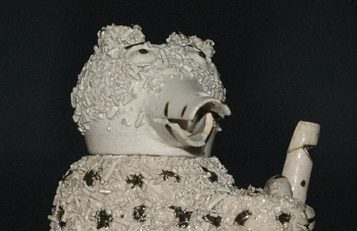
This technique involves adding small, sharp-edged fragments of clay to the surface of a vessel that is wet or coated in a wet slip. The clay fragments can be either multi-coloured, or all the same colour. Another option is to add a coloured glaze. Encrusted wares can be earthenware vessels (like those produced, e.g., at Oberode in southern Lower Saxony or Straubing in Bavaria) and can also be coated in salt glaze (as seen, e.g., in white salt-glazed stoneware bears from Staffordshire). In the late 18th century, refined white earthenware (pearlware) vessels with encrusted surfaces were also produced in Staffordshire.
Translation Sandy Haemmerle
German: Gesandelte Ware (inkrustrierte Oberflächen)
French: Céramique granulée/incrustée (incrustations dans la surface)
References:
Carpentier/Rickard 2001
Donald Carpentier/Jonathan Rickard, Slip Decoration in the Age of Industrialization, in: Ceramics in America 2001, 115-134.
Endres 2005
Werner Endres, Straubinger Renaissancekeramik (Katalog des Gäubodenmuseums Straubing 30), Straubing 2005.
Hampe 1990
Heinrich Hampe, Ein Töpferofen aus dem 16. Jahrhundert. Grabungsfunde aus einer Töpferei der Renaissance im ehemaligen Töpferzentrum Oberode a.d. Werra, in: Arbeitsgemeinschaft Südniedersächsischer Heimatfreunde e.V. (Hrsg.), Archäologie in Südniedersachsen (Schriftenreihe der Arbeitsgemeinschaft Südniedersächsischer Heimatfreunde e.V. Nörten-Hardenberg, 1990, 163-191.

